Member Spotlights: 2020
December 16, 2020
This year SDA spotlighted many amazing members on our blog, and we wanted to round them all up in one place to remind you of all the work they’ve done! Below is the work of Judy Bales, Polly Bech, Angela Dale, Julia Feldman, Leslie Horan Simon, Susan Hotchkis, Saberah Malik, Susan Moran, Jennifer Lee Morrow, Julie Nocent-Vigil, Anubha Sood, and Myrna Tatar. Click their names to read more in their individual blog articles.
Polly Bech
“Most of my recent pieces incorporate cotton that I have solar printed, a technique I learned from a kit of Setacolor Transparent paints and have been working on for years. I collect leaves and make prints of them using sun sensitive paint. You can create many different effects by mixing and layering the paint, and by throwing salt on the paint while it is wet. For years I used Setacolor transparent paints, like the ones from my original kit, but they have been hard to come by in the last few years, soI have been trying out a few other brands. The different makes of paint have unique palettes and consistencies; I am still in the process of experimenting with them.” pollybech.com
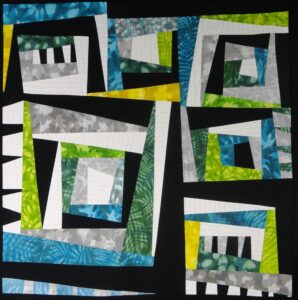
Polly Bech Off Kilter 2019, cotton, solar-printed, machine-pieced, hand-quilted, 46” x 46”.
Angela Dale
“I work a lot with dancers and the relationship of a body in motion to a garment’s kinetic potential is something that I am constantly looking to capitalize on. The choice of material, cut and drape can either accentuate or hinder a bodies movement and I am always interested in the performative aspects of this. I will make choices according to the message I am trying to convey.I work a lot with dancers and the relationship of a body in motion to a garment’s kinetic potential is something that I am constantly looking to capitalize on. The choice of material, cut and drape can either accentuate or hinder a bodies movement and I am always interested in the performative aspects of this. I will make choices according to the message I am trying to convey.” fabricadabra.ca
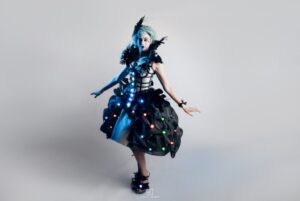
Angela Dale Rococo Glo 2016. Photo: Kelly Hofer.
Susan Hotchkis
“My inspiration is mainly found on my travels but I can find it on my doorstep too. I’m drawn to texture, surface, and colour, strongly influenced by the Japanese aesthetic of wabi-sabi. It’s the relationship between the natural elements and the man-made, such as that resulting from erosion and human use that interests me most. My aim is to create abstract pieces that hover between object and image and speak of imperfection. The starting point are my photographs, manipulated on the computer, zooming in, abstracting them for patterns, marks, and colour references that can then be used for printing and embroidery.” suehotchkis.com
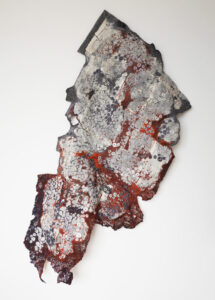
Susan Hotchkis Treasure-Trove 2019, voile, paper, 46.5” x 28”.
Susan Moran
“Although much of my imagery comes from observing plants, both wild and cultivated, I am also interested in the juxtaposition of natural and man-made objects that I notice on my walks, and I have begun to mix these together to create hybrid images, and to comment on the interaction of humans and nature. I use silkscreen, stitch-resist dyeing, collage, and embroidery to embed the images in the fabric. It’s important to me that the work builds slowly, involving meditative processes that connect me to the cloth and the source of the design. I hope always to create work that is a haven, that celebrates nature’s marvels and brings attention to its fragility.” susanmorantextiles.com
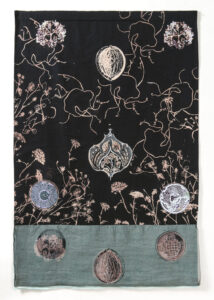
Susan Moran Incantation 2017, silkscreen, stitching, collage, 35″ x 52″.
Julia Feldman
“I gravitate toward forms both huge and microscopic. Combining the animal and minerals, what is made by nature and components of human design, this pillaging of existing paraphernalia and combining it with tangible prophecy based in facts, is an ongoing source of fascination and deep aesthetic pleasure. I find the trappings of society rearranged and viewed differently than the original intent continually engaging.” juliafeldmanartist.com
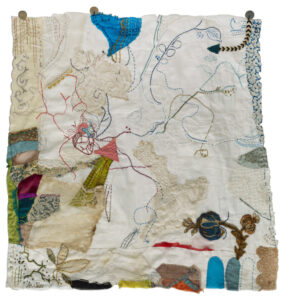
Julia Feldman Fragile (with pomegranate and rocket) 2018, hand embroidered, threads, yarns, appliquéd, quilted, vintage fabrics, cotton, thread, safety pins, vintage trims, 24” x 27”.
Julie Nocent-Vigil
“Series and repetitive mark-making with stitch and print are deeply connected to the act of marking hallowed space in my practice. I recall and create a landscape map using the physical process of joomchi, folding a plane of hanji (Korean mulberry paper) in multiple directions, working with it in a cyclic and repetitive manner. This cyclic process becomes intrinsically tied for me to an understanding prairie space: traveler coincident with center, where direction (north) can be elusive, and there are always the echoes of center and sensed arcs. The process recalls and textile artifact maps memory, impression, loss, orientation and disorientation, in the experience of place.” highdesertps.com
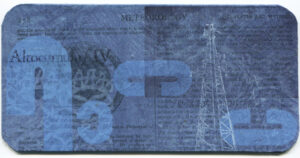
Julie Nocent-Vigil Altocumulus, Card IV from Cloud Deck for Prospero 2016, letterpress on dyed encyclopedia page, mounted on book board, 7.6″ x 3.8”.
Myrna Tatar
“My art is very spontaneous and optimistic, with layers of personal narrative and meaning woven throughout. I never plan or sketch anything out before I start. It just evolves and changes until it’s done. Although I work in a variety of mediums, my art is primarily oriented by assemblage. My studio space in San Francisco is a chaotic variety of many found and collected treasures that constantly inspire me to put unexpected objects together. For me, it is important to see and touch all the possibilities I could use. Tactile intuition guides my art-making.” myrnatatar.com
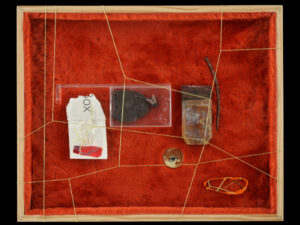
Myrna Tatar Mendocino On The Fly 2018, leather, fabric, paper, plastic, metal, wood, cotton thread, 17.25” x 21.25″ x 2”.
Judy Bales
“Working intuitively, my process involves decision making at every point. This is exhilarating but incredibly stressful when creating a line of artwear for a specific event. I adjust and refine the pieces up until the last minute, usually tweaking even as models line up to walk the runway. Every time I commit to a fashion event I promise myself I will be finished ahead of time. However, it is apparently in my nature to continually change and adjust my work. In a lifetime of making art, I have made peace with this part of myself, along with the stress it brings, and now embrace it as essential to my artistic process.” judybales.com
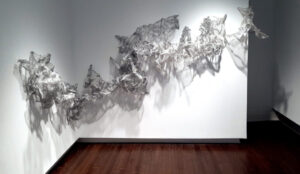
Judy Bales Start Flock 11 2020, aluminum screen, 48” x 30” x 180”.
Jennifer Lee Morrow
“Since delving into paper, I have explored Western and Eastern hand papermaking, paper sculpture, paper decoration, paper cutting and piecing, collage, and now bricolage–the art of creating with a diverse range of available objects and materials. Whereas at one time, I would carefully cook, clean, and hand beat kozo or gampi before spending hours pulling sheets, now I am as likely to snag an interesting scrap from the ground on my daily walks. My textile sensibilities have always influenced my work. For example, I use repetitive actions from stitching to stapling to wrapping to build surfaces and structure.” jenniferleemorrow.com
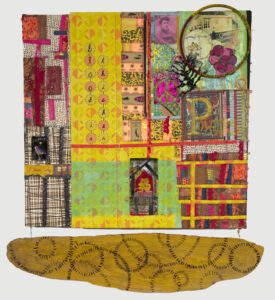
Jennifer Lee Morrow Then the Next Day 2019, found and altered papers, appropriated collage, found wood, found textiles, wire, nails, thread, 32” x 30” x 4”.
Saberah Malik
“Environmental consciousness and a personal passion paved the way for a predominantly fiber-art practice. I learnt to tie engineering principles to fiber manipulation; using a self-evolved method initiated through my understanding of fiber manipulation in shibori techniques, I transmute flat fabric into dimensional forms. Time-intensive shibori and my proprietary crafting processes are both a labor of love, demanding exacting repetition in the hundreds to design large installations in patient industry.” saberahmalik.com
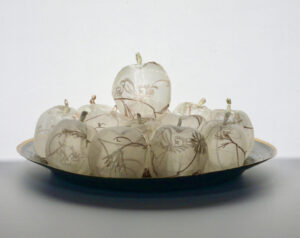
Saberah Malik Bountiful 2020, polyester fabric, antique metal tray, self evolved method for forming dimensional cloth, 7” x 16” x 16”. Photo by the artist.
Leslie Horan Simon
“My medium is wool. Not just any wool but that which comes from rare and endangered breeds of sheep. My interest in working with fiber started about ten years ago and has evolved into a passion for fiber as the basis of my artwork and for my activism as I seek to raise awareness about these rare and endangered breeds of sheep from around the world.” lesliehoransimon.com
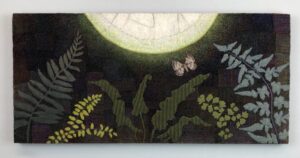
Leslie Horan Simon Attraction 2018, felt, ink, thread, 11” x 23.5”.
Anubha Sood
“My work emerges out of an urgency to engage the body in the act of making. It’s like plucking grass when you are sitting in a park and you don’t know what to do with your hands. You do what feels intuitive, for me, it’s weaving. Making cloth is a healing process and a catalyst for my body to respond to its environment. My practice is centered around the sustainable ecology of making that provokes a sentiment addressing our current systems of production and their entanglement with the natural world. How can we depart from the general sequence of design that is so strongly tied to functionality and manufacturing processes?” anubhasood.tumblr.com
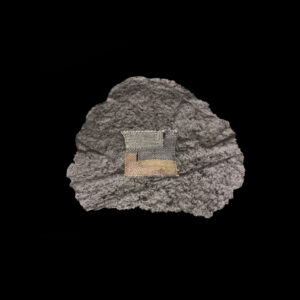
Anubha Sood Warps on Paper (series 1 of 5) 2019, handmade seaweed paper, soybean yarn, natural dyed with seaweed, 24″ x 14″. Photo by the artist.

Related Blog Articles
Angela Dale
Canada Craft Year 2020
Angela Dale
Member Spotlight: Angela Dale